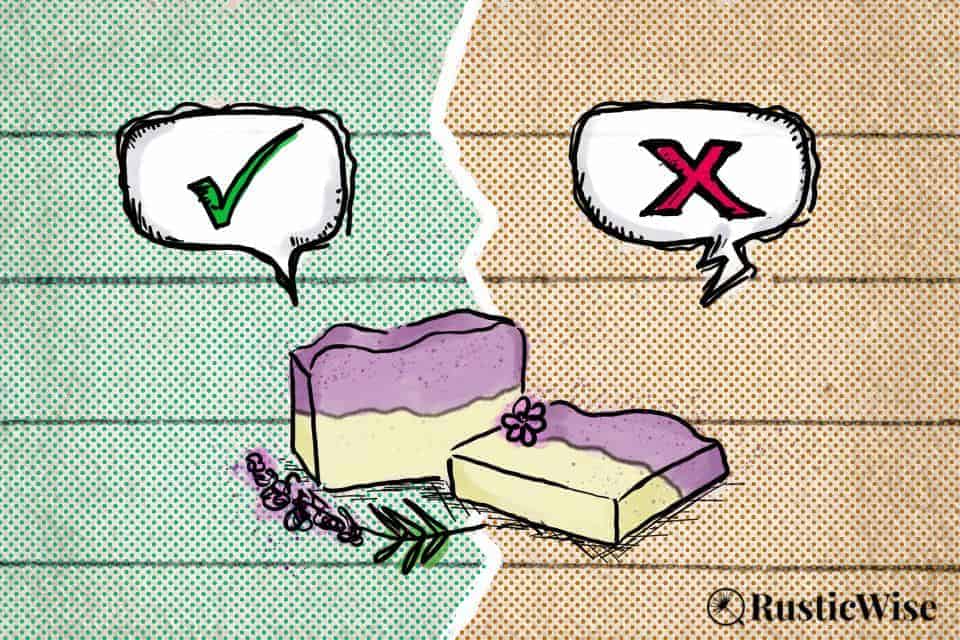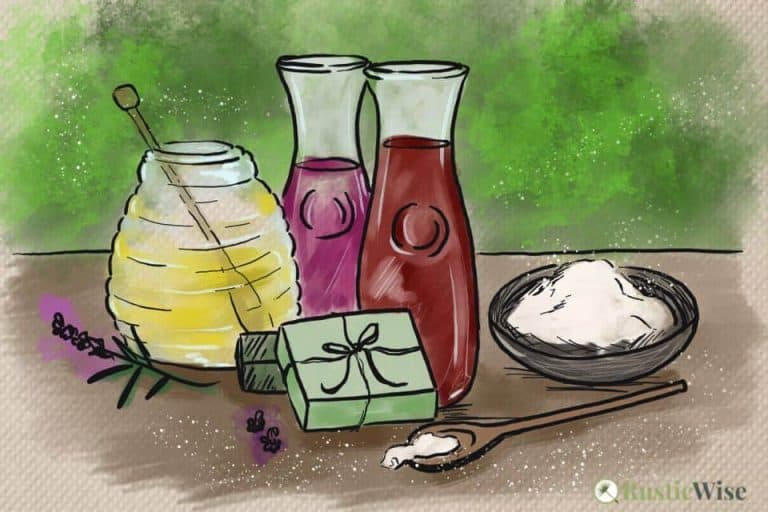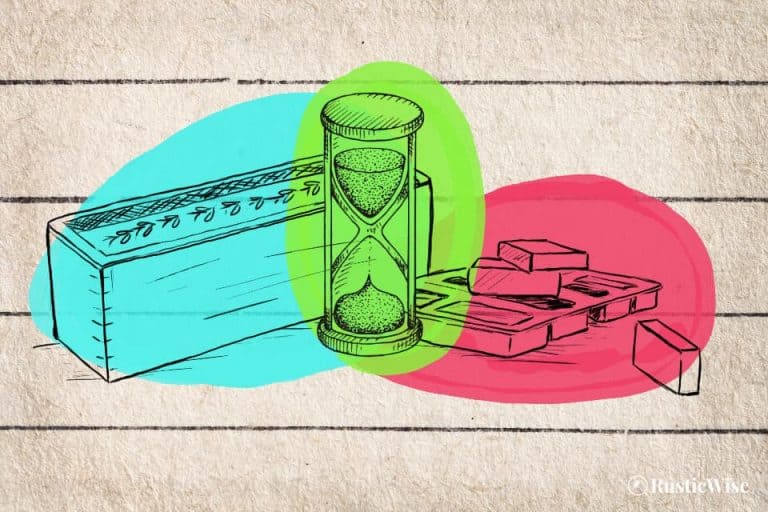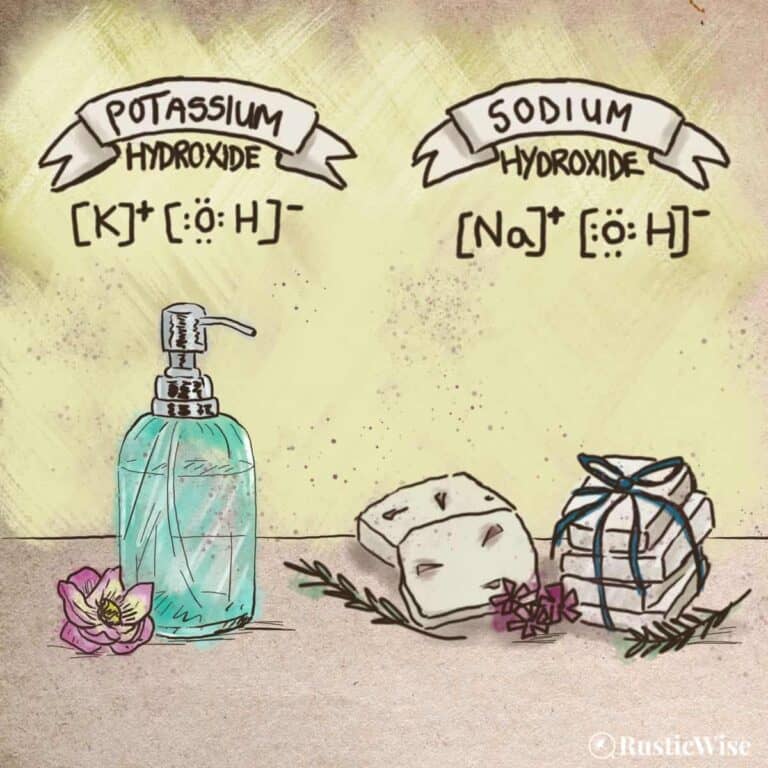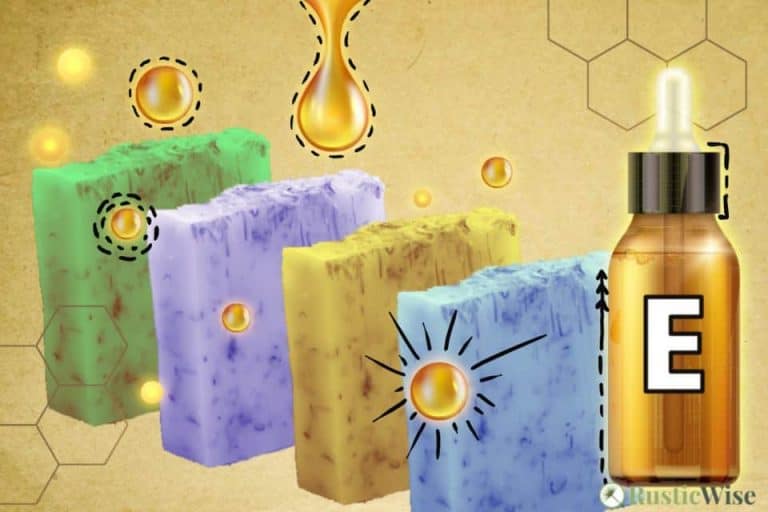7 Handmade Soap Facts (and 3 Myths Debunked)
There’s a lot of misinformation out there about making natural soap at home. To clear the cobwebs and set the record straight, I’ve rounded up seven handmade soap facts (plus debunk three common myths).
Some things are better when handmade. Chewy, homemade chocolate chip cookies, fresh-baked bread, and soap made from scratch are all things that beat store-bought, in my humble opinion.
Whether you make your own natural soap, or buy from a local vendor, let’s take a dive into the world of handmade soap!
A roundup of 7 handmade soap facts
Fact #1: All natural soaps made from scratch are made with lye
The use of lye in handmade natural soap is widely misunderstood. How can add something so caustic turn into something that’s safe to use on skin?
Lye is a strong alkali with a pH of around 13.5. When combined with either animal-based fats or vegetable oils, lye starts a chemical process called saponification. Saponification is just a fancy term for turning oils into soap.
At its most basic, traditional soap is made of three ingredients: distilled water, lye, and oils/fats/butters.
As you know, water and oils don’t mix. Lye is the key ingredient that brings together these unlikely molecules and produces something new—soap!
Without lye, you would have a gooey mess!
You might see recipes online that say “lye-free soap making.” This typically refers to melt and pour soap making.
This is a bit of a misnomer as melt and pour soap bases come already fully saponified. In other words, lye was used to make the soap base in the first place. The great thing about this method is that you don’t need to handle the lye. Simply melt the soap bases and pour into a mold!
Note: We use100 percent pure sodium hydroxide lye to produce hard bars of soap. Another type, potassium hydroxide lye is mostly used to make liquid soaps.
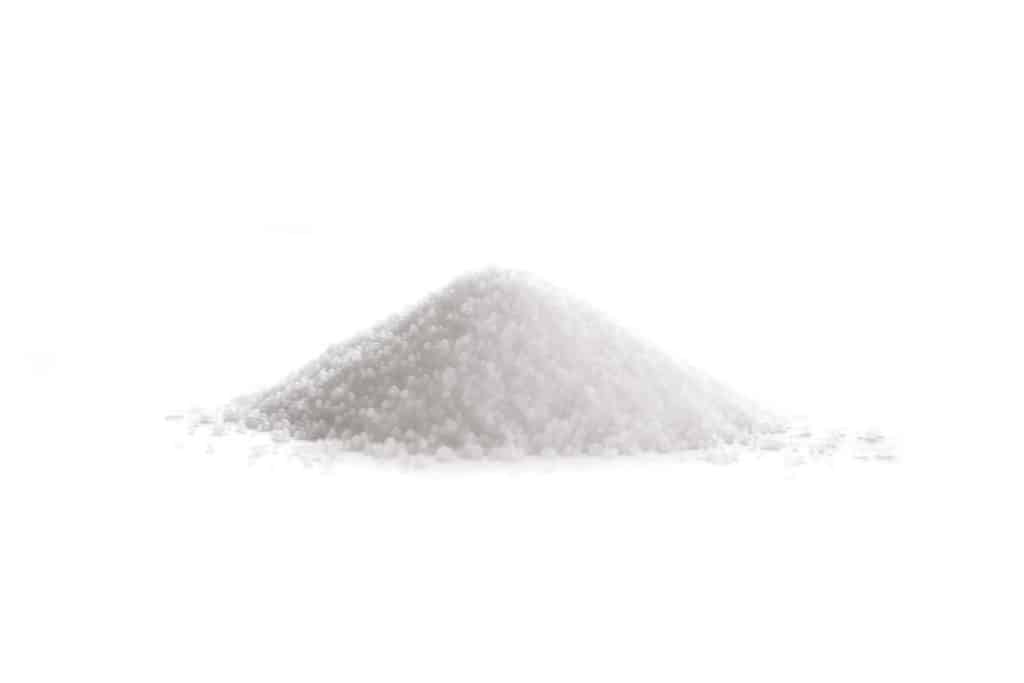
Credit: Deposit Photos
Fact #2: Handmade soap made with lye doesn’t contain lye in the finished product
If you’re worried about using a product made with lye on your skin, don’t worry—there’s no active lye in the finished soap. (If the soap making process has worked as it should!) This is one of the most important handmade soap facts to keep in mind!
Once soap has fully saponified, there should be no active lye in the finished soap. If the soapmaker has carefully measured out all ingredients, emulsified the soap mixture, allowed the soap to harden and cure, the soap is now safe to use.
Every soap making oil has a unique SAP value (a saponification value). This is just how much lye is required to convert oil into soap.
To stay on the safe side, most soapers add extra oils as a safety buffer (and for extra moisturizing properties). This is called superfatting. It ensures all active lye neutralizes and leaves a little extra for good measure.
Fact #3: Natural soaps are rich in glycerin
If you’re looking for a bar of moisturizing soap, natural soap is full of glycerin. A natural humectant, glycerin helps draw and retain moisture on the skin.
Glycerin is a natural byproduct of the saponification process. When you combine a strong alkaline base (lye) with oils or fats, a chemical reaction forms to produce soap and glycerol (glycerin).
Triglycerides (oils/fats) + alkali (lye) = soap + glycerin (a natural emollient that occurs during the soap making process.)
Commercial chemists work to produce glycerin in order to extract it for other personal care products such as creams, lotions, and hair products.
Glycerin is a skin nourishing powerhouse. It works to hydrate skin from the inside out. It creates a natural barrier on the surface of skin to hold in moisture, while also drawing moisture from the atmosphere.
Fact #4: Handmade soap is “real” soap—not a synthetic detergent
The FDA defines soap as primarily made of the “alkali salts of fatty acids.”¹ In other words, natural soap is the product you get when you combine fats/oils/butters with a strong alkaline base (sodium hydroxide lye).
If a product contains synthetic detergents, the FDA classifies it as a cosmetic.¹ And this is exactly what most of the products you see on shelves today are. This includes liquid soaps, body washes, facial cleansers, and bar soaps.
The purpose of soap is to clean. And, this is exactly what natural soap does.
Fact #5: Old-timers made their own lye using hardwood ashes
For generations, people have created natural lye by creating a slurry of hardwood ashes and rainwater (or distilled water).
The traditional way to do this is to collect hardwood ashes, and create a filter in a wooden barrel using straw or hay. Rainwater would sit and percolate with the ashes to produce an alkaline solution that would eventually leech out the bottom.
Homesteaders would combine this homemade lye with animal fats such as lard or tallow to produce a crude traditional soap.
This method of using hardwood ashes to create lye produces potassium hydroxide (KOH), sometimes called potash lye. Soap made using this type of lye produces softer soaps or liquid soap.
Today, soapmakers use sodium hydroxide to produce smooth cold process soap, or rustic-looking hot process soap.
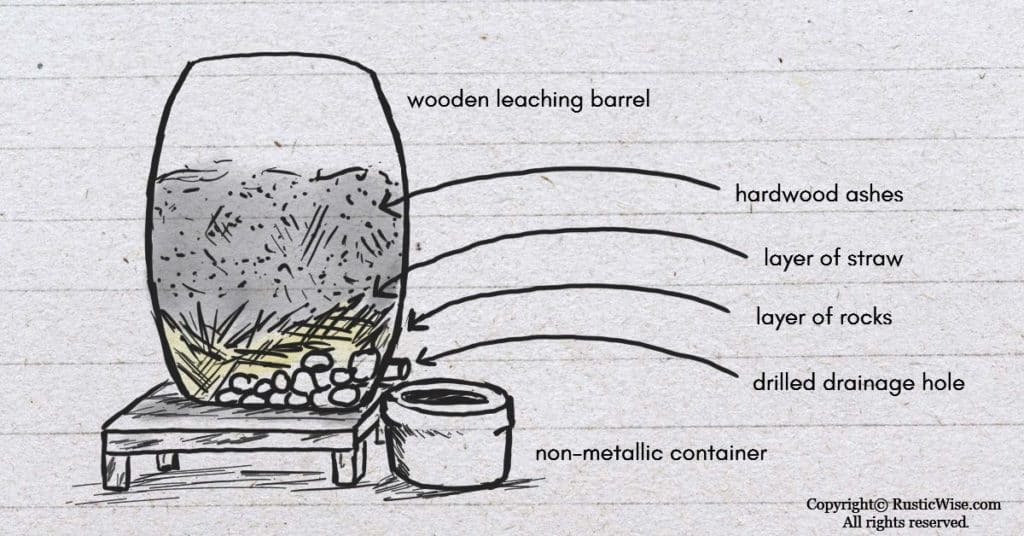
Fact #6: Handmade soap is safer for your body
A bar of soap made with natural ingredients doesn’t contain harmful chemicals that may disrupt the body’s natural balance.
If you look at the ingredients label on many commercially made soaps, you’ll see synthetic detergents/surfactants, artificial colorants, synthetic additives, as well as synthetic fragrances.
Many commercial soaps use sulphates—special substances that boost lather. Most use sodium lauryl sulphate (SLS) and sodium laureth sulphate (SLES). SLS and SLES are irritants to eyes, skin, and lungs.²
While that store-bought shampoo or soap smells like a bed of roses, the effects of synthetic fragrances are not so rosy.
They compose most synthetic fragrances of dozens of unlisted chemicals—the U.S. Food and Drug Administration (FDA) doesn’t require manufacturers to list all ingredients in a fragrance concoction.
A 2016 study looked at a variety of scented household products and their effects on human health.³ Over one-third of Americans reported adverse health effects from exposure to scented consumer products. Most commonly, people suffer from respiratory issues and migraines.
Plus, most manufactured liquid detergents require synthetic preservatives to keep them shelf stable.
So if you have sensitive skin, for example, you may find that a handmade bar of olive oil soap provides gentle moisturizing properties with no harmful toxins or harsh ingredients.
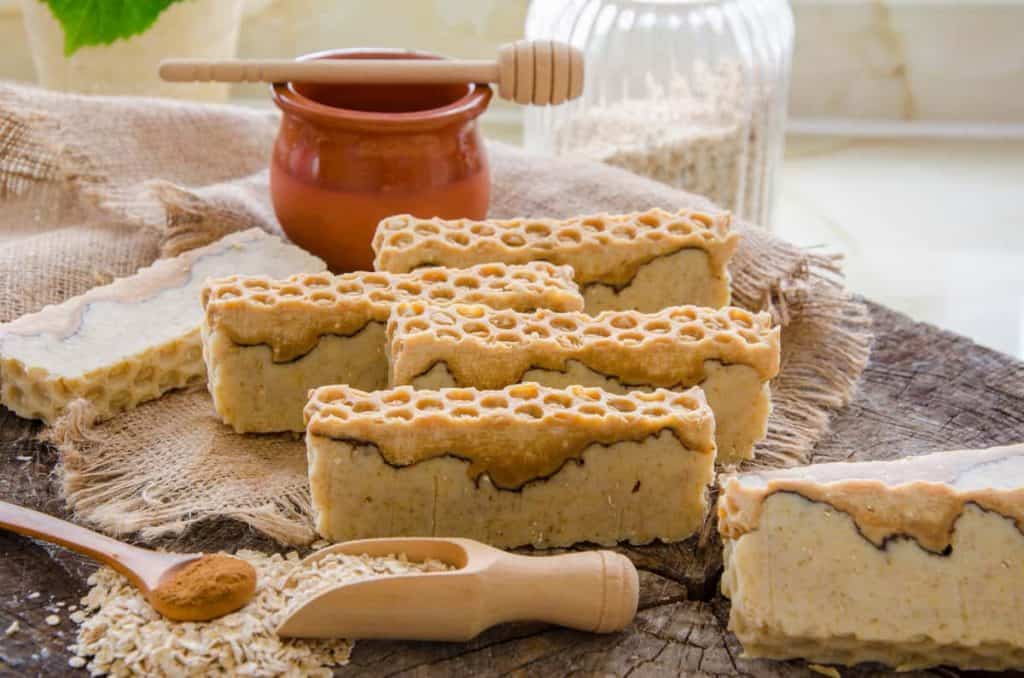
Credit: Vector State
Fact #7: Handmade soap is better for the environment
Most people would agree that the less plastic used, the better it is for the environment. This is the main argument in praise of natural bar soap over liquid soap that comes in plastic bottles.
Sure, some would argue that plastic bottles are recyclable. But the extent to which they are actually effectively recycled is a gray area.
Liquid soaps leave a larger carbon footprint from transportation to packaging, and also don’t last as long as bars of soap.
Whether you’re making your own homemade soap, or buying one from a local vendor, most organic soaps come with minimal packaging.
So now that we covered a few handmade soap facts, let’s take a look at a few common myths.
Myths about handmade soap debunked
Myth #1: A plain bar of soap isn’t as effective as antibacterial soap
According to the U.S. Food & Drug Administration (FDA), you can stick with plain soap and water when washing your hands—you don’t need soaps marketed as antibacterial for everyday use.⁴
Using plain soap and water reduces bacteria on hands by 82 percent.⁵
The FDA banned Triclosan and triclocarban, two ingredients that were once prevalent in antibacterial soaps, in 2016 as manufacturers couldn’t prove its long-term safety. Manufacturers also couldn’t show that soaps with triclosan are more successful at cleaning than regular soaps.
Triclosan is linked to many health problems in different areas, including heightened asthma, hormone disruption, and poor gut bacteria. However, more studies are needed.
In healthcare settings, they still use triclosan in some products.
Myth #2: All handmade soaps contain all-natural ingredients
A handmade bar of soap is only as natural as the ingredients put in it.
This may come as a surprise, but we shouldn’t assume that a lovingly crafted bar of handmade soap from the local farmer’s market is 100 percent organic or natural.
Handmade soaps may still contain synthetic dyes, additives, or fragrance oils.
Just as we should be wary of commercially produced products with the terms “natural” or “organic” (because those two terms are unregulated), we need to approach handmade soap with the same caution.
The best bet is to check the ingredients label, or to have a friendly chat with the soapmaker.
Myth #3: Bar soaps transmit disease
There’s an “ick” factor involved when using a bar of soap, especially one that someone else has just used. Many people wonder if a bar of soap someone else has used harbors harmful bacteria.
First, there’s no getting away from bacteria. Bacteria exist everywhere—from the surface of a bar of soap to the dispenser containing liquid soap.
The question isn’t really whether bar soap contains bacteria (yes, it does), but if a bar of soap can transmit disease. And it doesn’t appear it does.
A few studies suggest that using soap bars does not transmit bacteria from one person to another. A widely cited 1988 study tested this concept.⁶
Researchers inoculated soap bars with bacteria (Escherichia coli and Pseudomonas aeruginosa). They then asked 16 participants to wash their hands as normal using the soap bars. None of the participants had detectable levels of the test bacterium on their hands. (This study was commissioned by a soap manufacturer, so you may take the results with a grain of salt.)⁶
However, the CDC still recommends using either bar soap or liquid soap to wash your hands.⁷
So sing the birthday song twice while washing your hands. And wash well, and frequently to stay clean and healthy!
Related questions
How do you make soap without lye?
To make soap without having to handle lye, you can make melt and pour soap. In a nutshell, you can find a variety of soap bases such as goat’s milk, glycerin, or coconut oil that come already saponified. You melt the soap base, add any essential oils, colorants, or additives, and pour into molds.
Check out our intro to melt and pour techniques.
How long will handmade soap last?
Since most natural soaps made from scratch don’t contain synthetic preservatives, they may not last as long as store-bought kinds. However, most natural soaps are best used within one year.
There are many variables that affect how long a bar of homemade soap will last. The oils used (some oils have shorter shelf lives), whether the soap has properly cured, and how the soap is stored, to name a few.
New to making soap? 🧼❓
👉We have a fantastic overview on the whole soapmaking process here: read our Timeless Guide To Soapmaking.
If you would like to see our soapmaking posts organized by topic type, see our Soapmaking Collection.

References
- U.S. Food & Drug Administration (FDA), Frequently Asked Questions on Soap, https://www.fda.gov/cosmetics/cosmetic-products/frequently-asked-questions-soap. Accessed January 2022.
- Environmental Working Group (EWG), SODIUM LAURYL SULFATE, https://www.ewg.org/skindeep/ingredients/706110-SODIUM_LAURYL_SULFATE/. Accessed January 2022.
- Steinemann, A. Fragranced consumer products: exposures and effects from emissions. Air Qual Atmos Health 9, 861–866 (2016). https://doi.org/10.1007/s11869-016-0442-z. Accessed January 2022. https://link.springer.com/article/10.1007/s11869-016-0442-z
- U.S. Food & Drug Administration (FDA), “Antibacterial Soap? You Can Skip It, Use Plain Soap and Water,” https://www.fda.gov/consumers/consumer-updates/antibacterial-soap-you-can-skip-it-use-plain-soap-and-water. Accessed January 2022.
- Rangel, Gabriel (09 January 2017), “Say Goodbye to Antibacterial Soaps: Why the FDA is banning a household item,” Harvard University. Accessed January 2022.
- Heinze, J E, and F Yackovich. “Washing with contaminated bar soap is unlikely to transfer bacteria.” Epidemiology and infection vol. 101,1 (1988): 135-42. doi:10.1017/s0950268800029290 https://pubmed.ncbi.nlm.nih.gov/3402545/
- Centers for Disease Control and Prevention (CDC), Frequent Questions About Hand Hygiene, https://www.cdc.gov/handwashing/faqs.html#soap. Accessed January 2022.

Author: Theresa Tesolin
Theresa is co-founder of RusticWise. She helps people unleash their inner DIY spirit by encouraging them to get dirty and make or grow something from scratch.

